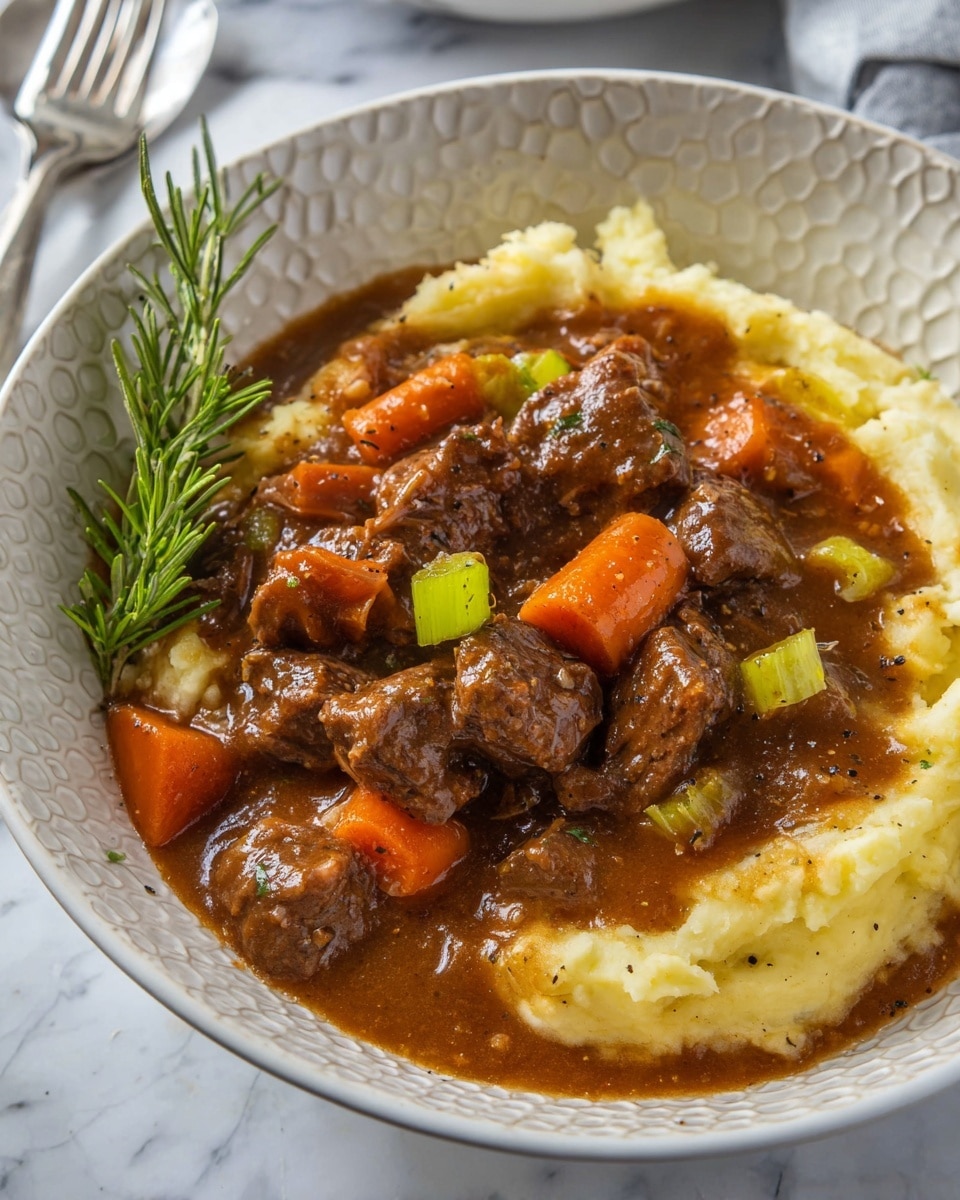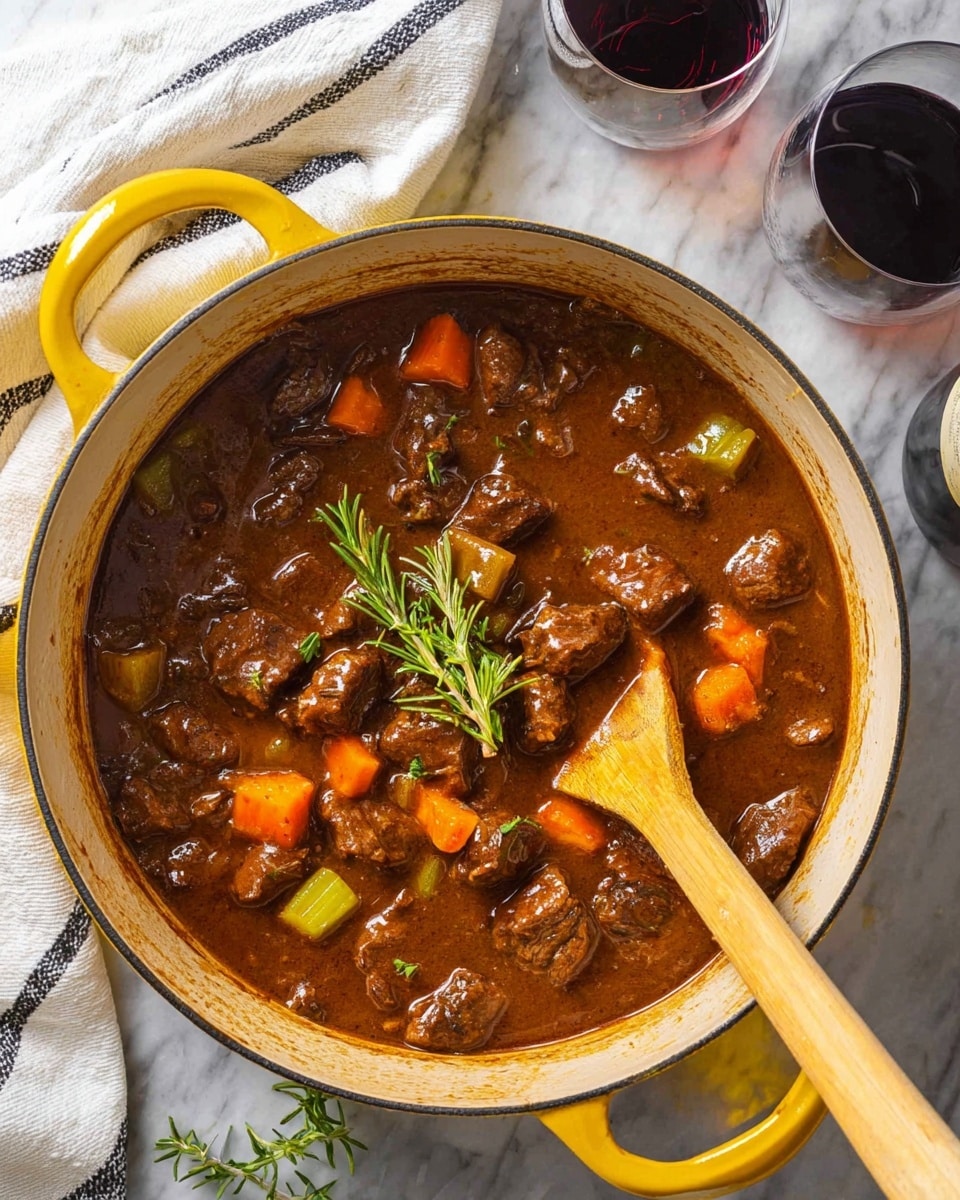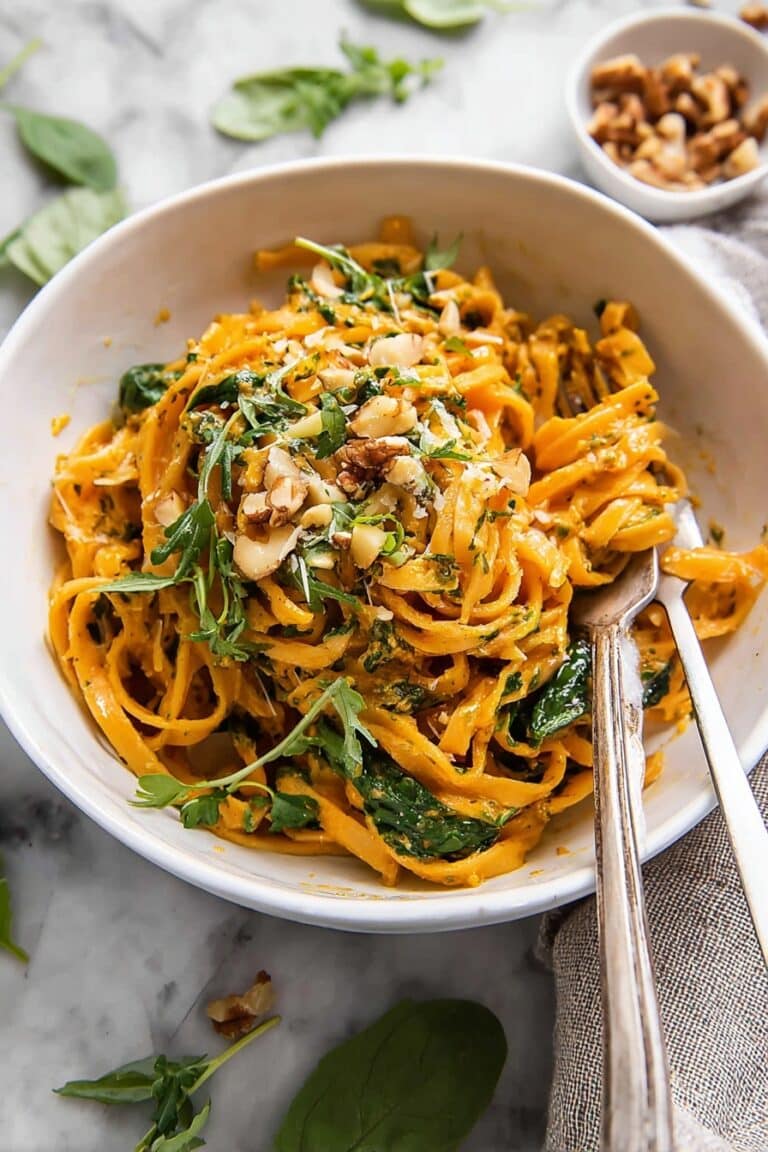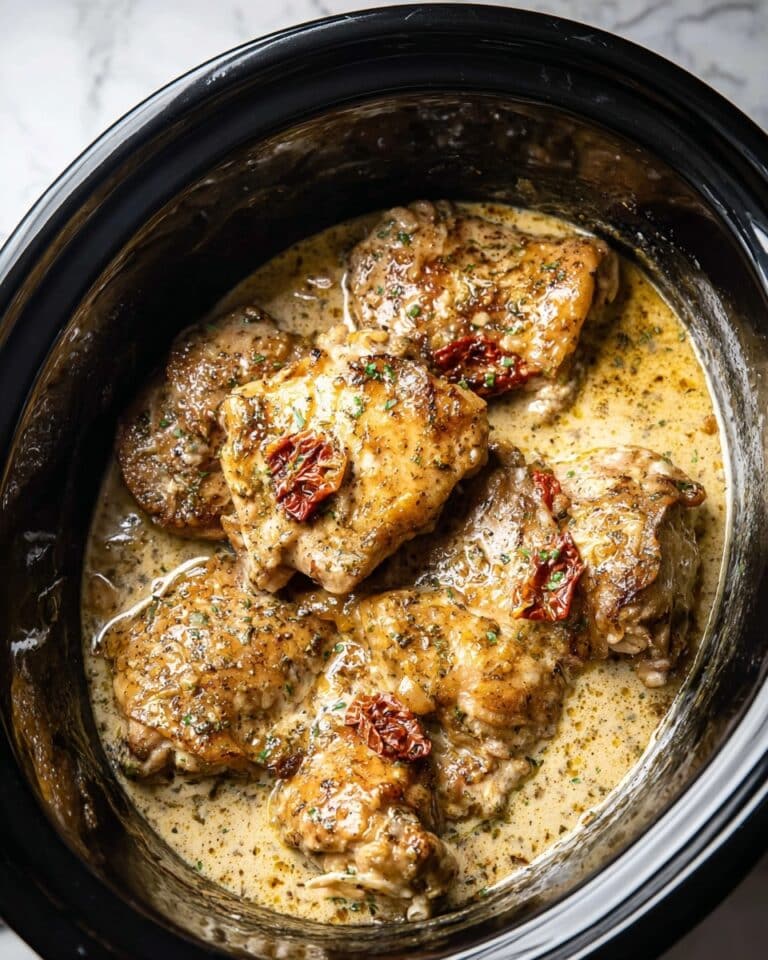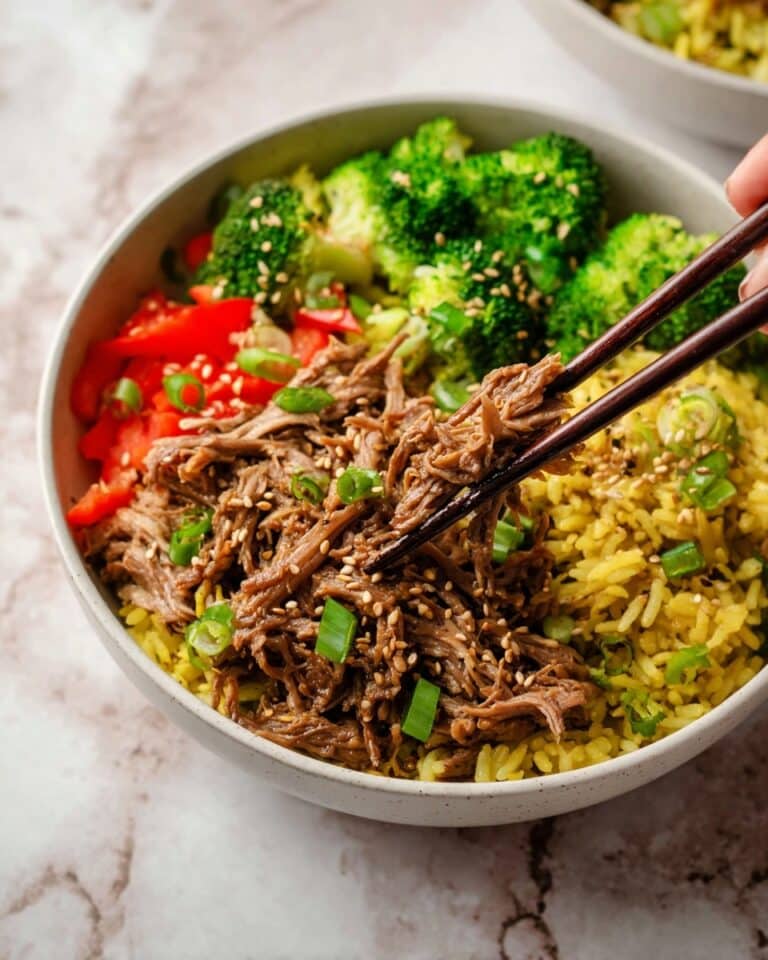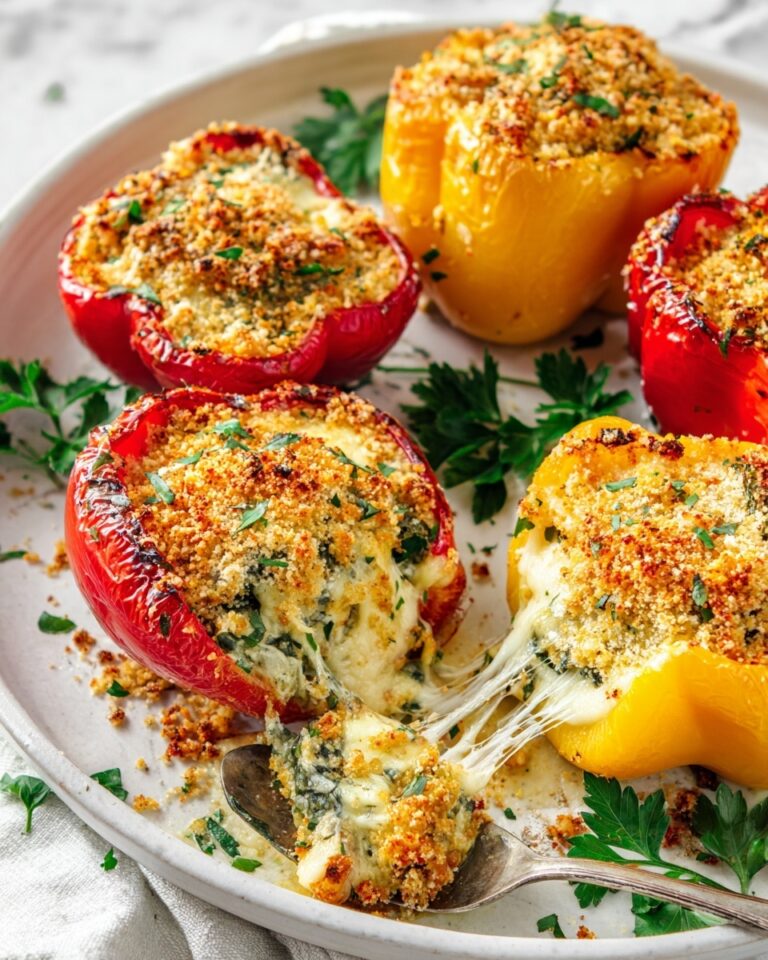Red Wine Beef Stew Recipe
Nothing says comfort like a hearty Red Wine Beef Stew Recipe bubbling away on the stove, filling your home with those rich, mouthwatering aromas. This recipe has been one of my go-to dishes when I want something cozy and impressive without a complicated fuss. The slow-simmered beef, steeped in red wine and fragrant herbs, just melts in your mouth, making every spoonful downright satisfying.
Whether it’s a chilly weekend afternoon or a dinner gathering with friends, this Red Wine Beef Stew Recipe always hits the spot. What I appreciate most is how versatile it is — you can make it ahead, tweak the veggies, or adjust the thickness just how you like. Plus, the red wine adds an elegant depth of flavor that transforms a simple stew into something truly special.
Why This Recipe Works
- Rich Flavor Depth: The red wine and fresh herbs marry perfectly with the beef for a deeply aromatic and satisfying stew.
- Tender, Juicy Beef: Slow simmering transforms tougher stew meat into melt-in-your-mouth goodness.
- Balanced Vegetables: Carrots, celery, and onions add sweetness and texture without overpowering the stew.
- Easy Thickening Technique: The simple flour slurry thickens the sauce just right for ultimate comfort food vibes.
Ingredients & Why They Work
The ingredients here come together like old friends at a dinner table — classic, trustworthy, and with each one playing a crucial role. Some small tips before you shop: go for a decent red wine you’d enjoy drinking, and choose fresh herbs to really make this stew sing.
- Stew Meat: Opt for chuck or another cut with good marbling, as the fat breaks down and enriches the stew.
- Coarse Salt: Essential for seasoning and bringing out the natural flavors in the beef and veggies.
- Black Pepper: Adds a subtle heat and depth without overshadowing other ingredients.
- Olive Oil: Perfect for browning the beef and sautéing vegetables with a little fruity note.
- Sweet Onion: Brings a gentle sweetness that balances the wine and herbs.
- Carrots: Add natural sweetness and a slight crunch that softens perfectly when cooked.
- Celery: Provides aromatic earthiness and enhances the stew’s texture.
- Minced Garlic: A punch of flavor that complements the red wine and tomato paste.
- Tomato Paste: Intensifies the stew’s savory depth and helps deglaze the pan for richer sauce.
- Beef Stock: The base of the stew liquid, adding umami and heartiness.
- Red Wine: The star liquid that adds acidity, complexity, and a velvety finish.
- Dried Thyme: A subtle herbal note that pairs beautifully with red meat.
- Fresh Rosemary: Bright, piney flavor that lifts the stew and smells irresistible.
- Bay Leaves: Infuse an aromatic depth during simmering.
- Flour or Cornstarch: Used to thicken the stew into a luscious sauce.
- Water: To mix with the flour or cornstarch for a smooth slurry without lumps.
Make It Your Way
Over the years, I’ve played around with this Red Wine Beef Stew Recipe quite a bit, tweaking it according to mood and what I have on hand. Don’t hesitate to make it your own — a stew like this thrives on personalization.
- Variation: I sometimes swap the sweet onion for shallots or add a handful of mushrooms for earthiness — it’s delicious and adds another layer of texture.
- Dietary Modifications: For a gluten-free version, I always use cornstarch as the thickener and double-check my broth for gluten.
- Seasonal Changes: In the fall, a small diced parsnip or turnip complements the carrots beautifully.
- Spicy Kick: Occasionally, I add a pinch of smoked paprika or a dash of chili flakes for a gentle warmth without overpowering the flavors.
Step-by-Step: How I Make Red Wine Beef Stew Recipe
Step 1: Brown the Beef to Lock in Flavor
Start by seasoning your stew meat generously with the coarse salt and black pepper—that seasoning makes a huge difference in flavor right from the start. Heat your Dutch oven over medium-high heat with the olive oil, then sear the beef in batches. You want a nice golden-brown crust all around, which not only looks great but adds tons of flavor. Don’t overcrowd the pan; otherwise, the beef will steam instead of brown.
Step 2: Sauté the Vegetables and Build Your Base
Once your beef is out, toss the chopped onion, sliced carrots, celery, and minced garlic into the pot. Stir them around until they soften and release their sweetness—about 5-7 minutes. Then stir in the tomato paste; it’s a small step, but it really boosts the richness. Use your spoon to scrape up any browned bits stuck to the bottom — that’s flavor gold.
Step 3: Let It Simmer Low and Slow
Return the browned beef to the pot, then pour in the red wine and beef stock. Toss in your thyme, rosemary sprig, and bay leaves. Bring everything to a gentle boil before lowering the heat and covering the pot. This is where patience pays off—let your stew simmer gently for 1.5 to 2 hours until the beef is tender and the flavors have fused. You can peek occasionally to check liquid levels and give it a stir, but resist the urge to rush things.
Step 4: Thicken the Sauce to Perfection
Once the beef is tender, whisk together the flour (or cornstarch) and water until smooth to avoid lumps. Slowly stir the slurry into the stew, increasing the heat to medium. Keep stirring as it thickens, which should take a few minutes. This step turns your stew into a luscious, velvety sauce that clings beautifully to the beef and veggies.
Step 5: Final Seasoning and Serving Prep
Give the stew a taste and add salt or pepper if needed — sometimes the stew stock or wine affects how much seasoning you need. Don’t forget to fish out the rosemary sprig and bay leaves before serving. This little step saves your guests from an unexpected woody bite!
Tips from My Kitchen
- Patience is Key: Letting the stew simmer low and slow ensures tender beef and rich flavor — rushing it never works the same.
- Don’t Skip Browning: Those golden bits on the beef and in the pan add serious depth of flavor you won’t get otherwise.
- Wine Choice Matters: Use a dry red wine you enjoy drinking, like a Cabernet or Merlot — the flavor carries through the whole dish.
- Avoid Lumps When Thickening: Mix the flour or cornstarch with water first to a smooth slurry for a perfectly silky sauce.
How to Serve Red Wine Beef Stew Recipe
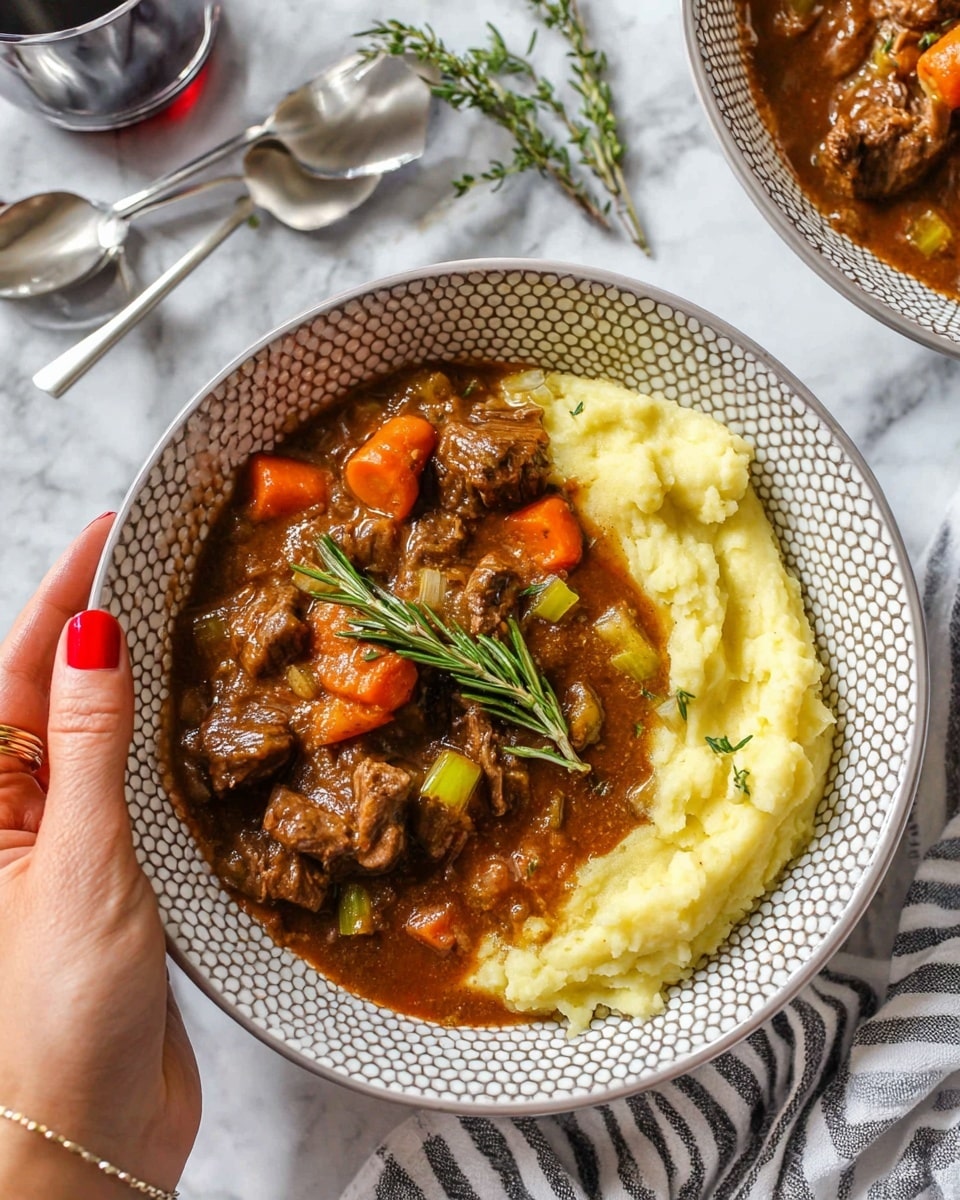
Garnishes
When I serve this stew, I love topping it with a sprinkle of fresh chopped parsley to add brightness and color. Sometimes, a little grated fresh Parmesan or even a dollop of sour cream takes it to the next level. It’s all about those little touches that make each bowl inviting and cozy.
Side Dishes
I typically serve Red Wine Beef Stew with creamy mashed potatoes or buttery noodles to soak up all that luscious sauce. Crusty bread is an absolute must for dipping, in my opinion — a warm baguette or sourdough is perfect. If you want something green, steamed green beans or a simple salad with a mustard vinaigrette can balance the richness.
Creative Ways to Present
For a dinner party, I like presenting the stew in individual rustic ramekins or mini cast-iron skillets — it makes the meal feel special without extra fuss. You can also top with crispy fried onions or a grating of fresh horseradish for a surprising twist. It’s all about presentation that invites your guests to dig in eagerly.
Make Ahead and Storage
Storing Leftovers
I usually let the stew cool completely and store it in airtight containers in the fridge for up to 4 days. I find that the flavors deepen even more after a day or two, so leftovers often taste better than when freshly made. Just be sure to reheat thoroughly before serving.
Freezing
This Red Wine Beef Stew Recipe freezes beautifully. I portion it into freezer-safe containers or bags, leaving some headspace for expansion, then freeze for up to 3 months. When you’re ready to enjoy, thaw overnight in the fridge and reheat gently on the stove.
Reheating
I prefer slowing reheating on the stovetop with a splash of water or broth to loosen up the sauce if it’s thickened too much. This method preserves the stew’s texture and keeps the beef tender rather than rubbery. You can also reheat in the microwave but do so gently in short bursts to avoid drying out.
FAQs
-
Can I use a different cut of beef for this Red Wine Beef Stew Recipe?
Absolutely! Chuck roast or beef brisket work best because their connective tissue breaks down during slow cooking, making the meat tender and flavorful. Avoid quick-cooking cuts like sirloin, as they tend to get tough.
-
What red wine should I use in this recipe?
Choose a dry red wine you enjoy drinking; common choices include Cabernet Sauvignon, Merlot, or Pinot Noir. Avoid sweet or cooking wines, as they can add off flavors to your stew.
-
How can I thicken the stew if I don’t have flour or cornstarch?
If you don’t have flour or cornstarch, you can reduce the stew uncovered to thicken it naturally, or mash some of the cooked vegetables to release their starch. Alternatively, using instant potato flakes works in a pinch.
-
Is the stew better the next day?
Yes! Like many stews, the flavors deepen and taste even more harmonious the next day. It’s ideal to make this recipe a day ahead when possible.
-
Can I make this recipe in a slow cooker?
You can, but I recommend browning the beef and sautéing the veggies first to build flavor, then transfer everything to the slow cooker with liquids and herbs. Cook on low for 6-8 hours or high for 3-4 hours until tender.
Final Thoughts
This Red Wine Beef Stew Recipe has become a real comfort classic in my kitchen — it’s one of those dishes that makes you feel taken care of, whether it’s a family dinner or a cozy night in. I hope you give it a try and find the same joy I do in that rich, hearty, and tender stew. Trust me, once you make it your own, it’s going to be on repeat for seasons to come!
Print
Red Wine Beef Stew Recipe
- Prep Time: 10 minutes
- Cook Time: 1 hour 30 minutes
- Total Time: 1 hour 40 minutes
- Yield: 8 servings
- Category: Main Course
- Method: Stovetop
- Cuisine: American
Description
This hearty Red Wine Beef Stew is a comforting, slow-simmered dish featuring tender chunks of beef, vibrant vegetables, and rich red wine flavor. Perfect for a cozy dinner, this classic stew delivers deep, savory taste with a luscious, thickened sauce.
Ingredients
Beef and Seasoning
- 2 pounds stew meat
- 2 teaspoons coarse salt
- 1/4 teaspoon black pepper
- 2 tablespoons olive oil
Vegetables and Aromatics
- 1 large sweet onion, chopped (about 2 cups)
- 4 carrots, sliced (about 3 cups)
- 2 stalks celery, sliced
- 1 tablespoon minced garlic
- 1 tablespoon tomato paste
Liquids and Herbs
- 1 cup beef stock
- 3/4 cup red wine
- 1/4 teaspoon dried thyme
- 1 sprig fresh rosemary
- 2 bay leaves
Thickener
- 2 tablespoons all-purpose flour (or 1 tablespoon cornstarch for gluten free)
- 1/4 cup water
Instructions
- Brown the beef: Season the stew meat with coarse salt and black pepper. Heat a large Dutch oven over medium-high heat and add olive oil. Sear the beef on all sides until browned. Remove the beef and set aside.
- Sauté the veggies: In the same pot, add chopped onion, sliced carrots, celery, and minced garlic. Sauté until vegetables are tender. Stir in tomato paste to coat the veggies and deglaze the pan, scraping up browned bits.
- Simmer the stew: Return the browned beef to the pot. Pour in red wine and beef stock, then add dried thyme, fresh rosemary sprig, and bay leaves. Bring the mixture to a boil.
- Slow cook the stew: Reduce heat to low, cover the pot, and let simmer for 1 hour and 30 minutes, or until the beef is tender and flavors meld together.
- Thicken the sauce: Whisk together flour (or cornstarch) and water until smooth. Increase heat to medium and stir this mixture into the stew. Cook until the liquid thickens, stirring frequently.
- Finish and serve: Adjust seasoning with salt and pepper if needed. Remove herbs before serving. Serve hot and enjoy the rich, hearty flavors.
Notes
- To make this recipe gluten free, use cornstarch instead of flour and ensure your beef stock is gluten free.
- For a deeper flavor, allow the stew to simmer longer until the meat is very tender.
- Use a good quality dry red wine suitable for cooking, like Cabernet Sauvignon or Merlot.
- If you prefer a thicker stew, increase the flour or cornstarch slightly when thickening.
- Leftovers taste even better after a day, as flavors continue to develop.
Nutrition
- Serving Size: 1 cup
- Calories: 350 kcal
- Sugar: 5 g
- Sodium: 450 mg
- Fat: 18 g
- Saturated Fat: 5 g
- Unsaturated Fat: 11 g
- Trans Fat: 0 g
- Carbohydrates: 16 g
- Fiber: 3 g
- Protein: 28 g
- Cholesterol: 80 mg

